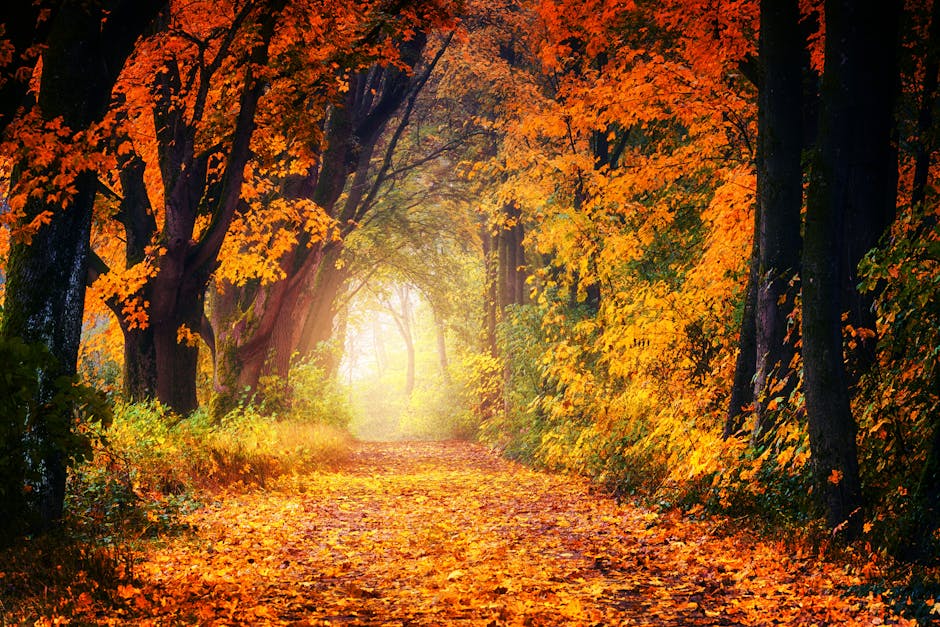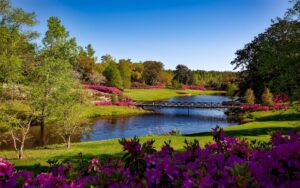Crisp air, golden light, and trees bursting with color make autumn the perfect time to get outside. While many people flock to the same crowded spots, you can find just as much beauty—and often more peace—by exploring lesser-known state parks. Underrated state parks across the country offer some of the most stunning fall landscapes without the hassle of heavy crowds.
You can wander through the fiery maples of Letchworth State Park in New York, where waterfalls cut through dramatic gorges, or breathe in the mountain air at Franconia Notch State Park in New Hampshire, where ridgeline trails open to sweeping views of New England’s foliage. The Midwest holds its own treasures too, from the rugged shoreline of Porcupine Mountains Wilderness State Park in Michigan to the quiet headwaters of Itasca State Park in Minnesota, where the Mississippi River begins its long journey.
Heading south, autumn takes on a different kind of charm. Lost Maples State Natural Area in Texas glows with rare pockets of bigtooth maples, painting the hillsides in shades of red and orange that stand out against the limestone cliffs. Each of these parks offers a unique way to experience the season, giving you the chance to slow down, take in the scenery, and enjoy fall in its most natural form.
Why Choose State Parks for Autumn Colors?
State parks give you a chance to see autumn colors in a quieter, more personal way. You can enjoy fall foliage at your own pace, away from busy tourist spots, while still exploring landscapes filled with a wide range of trees and natural features.
Intimate Fall Foliage Experiences
When you visit a state park in the fall, you often find smaller trail systems and lakeshores that feel more personal. Instead of rushing through crowded overlooks, you can stop and really take in the changing leaves.
Many state parks are built around local features like small canyons, glacial lakes, or hidden waterfalls. These spots let you see fall colors reflected on water or framed by rock formations.
You also get closer to the details. A walk through a maple grove lets you notice the crunch of leaves underfoot or the way sunlight filters through golden canopies. These small moments make the season feel richer than just checking off a big viewpoint.
Fewer Crowds Than National Parks
National parks often draw heavy traffic during peak foliage season, which can make trails and parking lots feel overwhelming. State parks usually don’t see the same level of attention, so you can explore without long waits or packed overlooks.
With fewer people around, you can take your time on the trails. You don’t have to rush to snap a photo before someone steps into the frame. It’s easier to find a quiet picnic spot or a bench with a view.
This also makes it simpler to plan last-minute trips. Camping reservations at national parks can book out months ahead, but many state parks still have open campsites or cabins well into the fall. That flexibility helps you enjoy the season without a strict schedule.
Diverse Landscapes and Tree Species
State parks cover a wide range of ecosystems, so you don’t just see one type of fall landscape. In the Northeast, you’ll find maples and birches turning bright red and yellow. In the Midwest, oaks and hickories bring deep golds and browns.
Head south and you’ll notice mixes of evergreens with sweetgum and dogwood trees, giving you longer stretches of color. Out west, aspens light up mountain slopes with golden leaves, while cottonwoods glow along rivers and canyons.
Because state parks are spread across different regions, you can experience fall foliage in many forms. Whether you want mountain views, lakeside trails, or forested valleys, these parks give you a variety of autumn colors without needing to travel far.
1. Letchworth State Park, New York: The Grand Canyon of the East
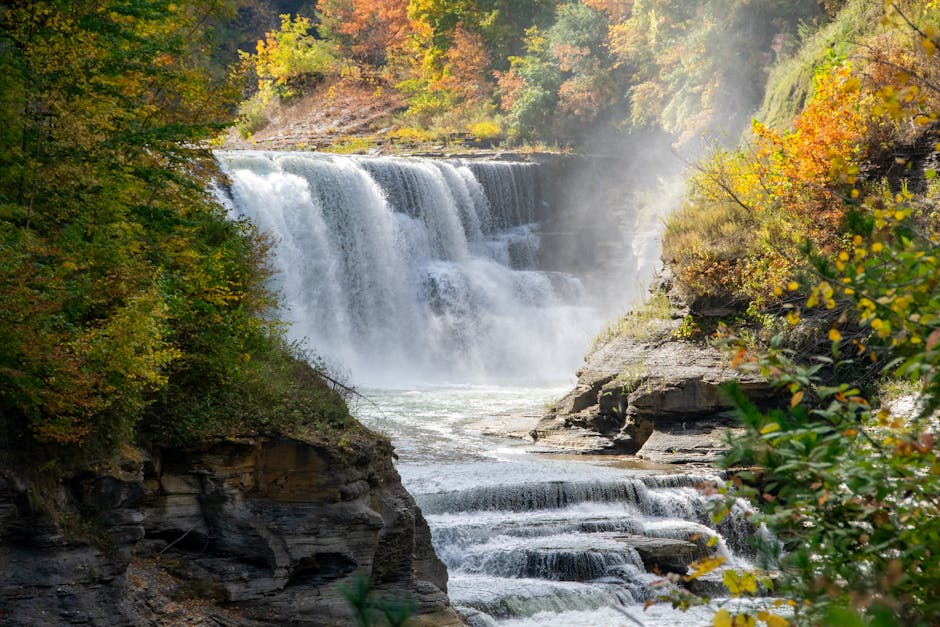
You’ll find dramatic cliffs, thundering waterfalls, and wide stretches of forest that make this park one of the best spots in the Northeast to enjoy fall. The mix of river views and colorful foliage creates a landscape that feels both rugged and peaceful at the same time.
Spectacular Gorge Views and Waterfalls
The Genesee River cuts through the park, creating a gorge with cliffs rising up to 600 feet. This is why Letchworth earned the nickname Grand Canyon of the East.
Three main waterfalls—Upper, Middle, and Lower Falls—are the main highlights. Each one has its own character, with the Middle Falls being the widest and most photographed.
You can view the falls from overlooks that are easy to reach by car or short walks. In autumn, the waterfalls are framed by trees bursting with shades of red, orange, and yellow, making them even more striking.
Vibrant Forests and Leaf-Peeping Opportunities
The park covers more than 14,000 acres, and much of it is dense forest. In fall, these woodlands turn into a patchwork of color that stretches across the gorge and rolling hills.
Maples bring bright reds, while oaks and hickories add warm oranges and golds. The mix of hardwoods means you’ll see a variety of shades all season long.
If you want the best leaf-peeping, head to spots like Inspiration Point or the overlooks near the Middle Falls. The views here let you see both the gorge and the forest canopy, giving you a wide angle of autumn color.
Hiking Trails for All Levels
With about 66 miles of trails, you can choose a route that matches your pace. Some trails follow the edge of the gorge, offering constant views of the river and cliffs. Others wind through quiet forests where you can enjoy the colors up close.
The Gorge Trail is one of the most popular. It connects many of the main overlooks and waterfalls, so you can see the highlights without needing to drive between them.
If you want something shorter, there are loop trails near picnic areas and parking lots. For longer treks, the Finger Lakes Trail passes through the park, giving you a chance to explore beyond the main viewpoints.
Best Times and Spots for Autumn Photography
Peak color usually arrives in early to mid-October, though the exact timing depends on weather. Early mornings often bring mist rising from the gorge, which adds atmosphere to your photos. Late afternoons give you softer light and warmer tones.
Some of the best photo locations include Inspiration Point, Archery Field Overlook, and the bridges near Upper Falls. These spots give you sweeping views of both the gorge and the trees.
If you want close-up shots, walk along the Gorge Trail where fallen leaves cover the ground and frame the waterfalls. The mix of water, rock, and color makes almost every angle worth capturing.
2. Franconia Notch State Park, New Hampshire: New England’s Autumn Gem
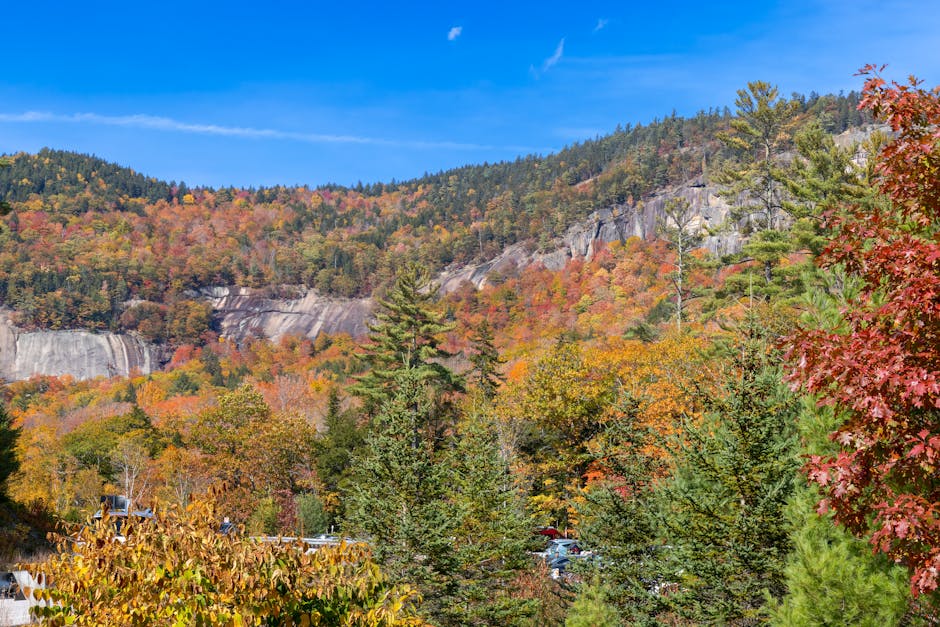
When you visit Franconia Notch State Park in the fall, you see more than just bright leaves. The mix of granite cliffs, deep gorges, and high ridgelines makes the autumn colors stand out in every direction.
Dramatic Mountain Scenery and Flume Gorge
One of the park’s most striking features is Flume Gorge, a narrow chasm carved by the Pemigewasset River. In autumn, the gorge’s 70–90 foot granite walls are framed by maples, birches, and oaks glowing in shades of red, orange, and gold.
You walk along wooden walkways that hug the rock walls, pass waterfalls, and cross covered bridges. The 45-foot Avalanche Falls is a highlight, and the sound of rushing water against the backdrop of fall foliage makes the setting even more memorable.
Outside the gorge, the surrounding mountains like Mount Lafayette and Cannon Mountain add drama to the landscape. Their steep slopes catch the morning light, and when the leaves peak, the entire notch feels like a natural amphitheater of color.
Appalachian Trail Adventures
The Appalachian Trail runs right through Franconia Notch, giving you access to some of the best ridge walks in New England. In the fall, sections of the trail offer wide-open views of valleys filled with autumn color.
A popular route is the climb to Lonesome Lake, about 1.5 miles each way. The lake reflects the surrounding peaks and trees, so you get two layers of color—one above and one mirrored in the water.
For a bigger challenge, you can hike the Franconia Ridge Loop, which connects Mount Lafayette, Mount Lincoln, and Little Haystack. This hike is demanding, but the reward is a sweeping panorama of the White Mountains painted in fall shades.
Cannon Mountain Tramway and Scenic Overlooks
If you want the views without the long climb, the Cannon Mountain Aerial Tramway is your shortcut. In less than 10 minutes, you rise to the 4,080-foot summit, where a short walk leads to an observation deck.
From the top, you can see into Vermont, Maine, and even Canada on a clear day. In autumn, the valleys below are filled with layers of red, yellow, and orange that stretch for miles.
Closer to the ground, stops like Artists Bluff and Echo Lake give you classic photo spots. Artists Bluff, in particular, is a short hike that rewards you with a perfect overlook of the notch framed by peak foliage.
3. Porcupine Mountains Wilderness State Park, Michigan: Lake Superior’s Wild Coast
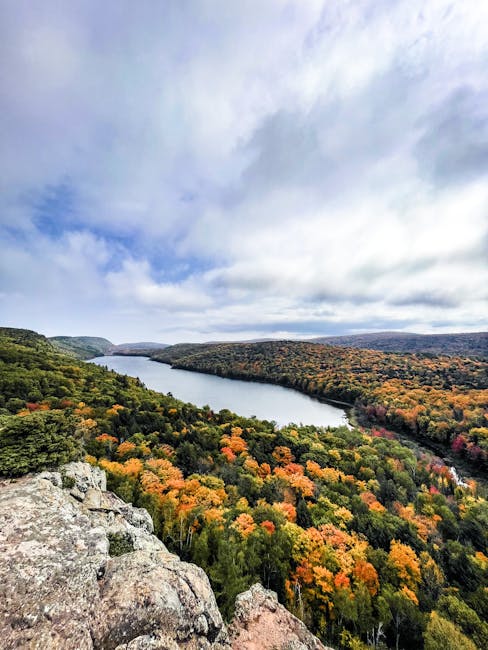
You’ll find a mix of rugged wilderness, bright fall colors, and dramatic water features in Michigan’s largest state park. The mix of forests, waterfalls, and Lake Superior views gives you plenty of ways to experience autumn in the Upper Peninsula.
Expansive Forests and Golden Aspens
When you walk into the Porcupine Mountains, you step into one of the Midwest’s largest old-growth forests. In fall, the hardwoods turn shades of red and orange, while the golden aspens add a bright glow against the evergreens.
The Lake of the Clouds overlook is one of the best spots to see this mix. From high above, you can watch the Carp River winding through ridges covered in color. The view stretches for miles, especially on clear days.
If you hike some of the 90-plus miles of trails, you’ll notice how the forest changes with the terrain. Hemlocks dominate shady valleys, while maples and birches light up the ridges. The variety makes every trail section feel different.
Bond Falls and Waterfall Exploration
Bond Falls is a must-see in autumn. It’s not inside the park boundary, but it’s close enough to add to your trip. The wide, tiered waterfall drops nearly 50 feet, and boardwalks let you see it from several angles. In fall, the trees around the river frame the rushing water with bright yellows and reds.
Inside the park, you’ll find dozens of smaller waterfalls. The Presque Isle River corridor is one of the most popular places to explore. Here you can walk short trails that lead to three major falls: Manabezho, Manido, and Nawadaha. Each one has its own character, and the mix of rocky gorges and colorful leaves makes the area stand out.
Pack sturdy shoes because the paths can be slick with mist. The sound of rushing water mixed with the crisp fall air is worth the effort.
Lake Superior Shoreline Vistas
The park also gives you direct access to Lake Superior’s shoreline, which feels wild and remote. In autumn, the contrast between the blue-gray water and the fiery colors of the forested bluffs is striking.
Union Bay Campground sits right on the coast, so you can hear the waves at night. If you walk the shoreline, you’ll see rocky beaches, sandstone cliffs, and driftwood scattered along the water’s edge.
Sunsets here are especially vivid in fall. The cool air often clears the sky, and the fading light reflects off both the lake and the golden treetops. It’s one of the best ways to end a day in the Porkies.
4. Itasca State Park, Minnesota: Birthplace of the Mississippi
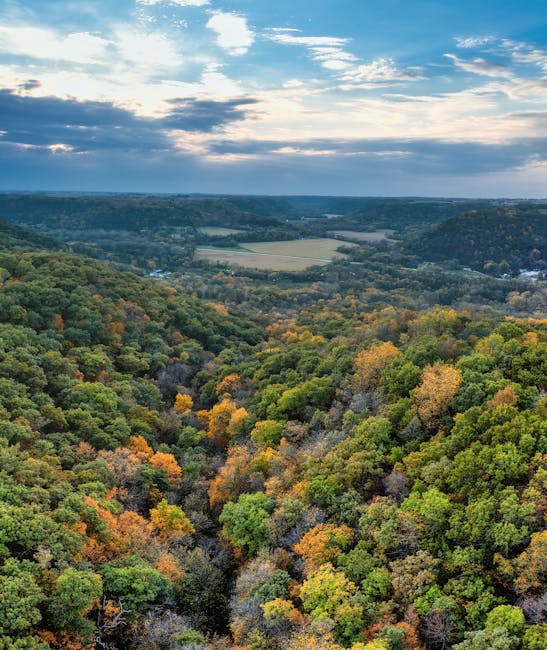
You can step across the start of the Mississippi River, wander through old-growth pine forests, and take in some of Minnesota’s brightest fall foliage. The mix of lakes, hardwood trees, and winding trails makes this park one of the best places to experience autumn in the upper Midwest.
Historic Headwaters Surrounded by Color
At Lake Itasca, you’ll find the headwaters of the Mississippi River. In fall, the shoreline glows with shades of red, orange, and gold as maples and birches mix with towering pines.
When you walk across the river’s first few feet, you’re surrounded by both history and seasonal beauty. The contrast of evergreen needles with changing leaves creates a unique backdrop for photos.
You can also explore historic sites like Preacher’s Grove, where old-growth red pines frame the colorful landscape. These trees stand as tall reminders of the park’s long history, adding depth to the autumn scenery.
Scenic Drives and Leafy Trails
Itasca offers more than 30 miles of hiking trails, many lined with hardwoods that turn brilliant in October. Short paths near the headwaters give you quick views, while longer loops let you wander deeper into the forest.
If you prefer to stay in your car, the Wilderness Drive Loop is a 10-mile scenic road that circles through the park. Along the way, you’ll pass overlooks, lakes, and picnic spots covered in fall color.
Biking is another option, with paved trails that make it easy to ride under canopies of yellow aspen and golden oak. Whether on foot, bike, or car, you’ll find plenty of ways to enjoy the foliage.
Wildlife and Photography Highlights
Fall is a great time to spot wildlife in the park. You might see bald eagles over the lakes, white-tailed deer moving through the woods, or loons finishing their season before migrating south.
Photographers often focus on the reflections of red and orange leaves in the park’s 100-plus lakes. Early mornings bring mist rising off the water, giving you calm and colorful scenes to capture.
With fewer crowds after summer, you’ll have more quiet moments to enjoy wildlife and landscapes. The mix of animals, lakes, and autumn colors makes Itasca one of Minnesota’s most photogenic state parks.
5. Lost Maples State Natural Area, Texas: Southern Maple Magic
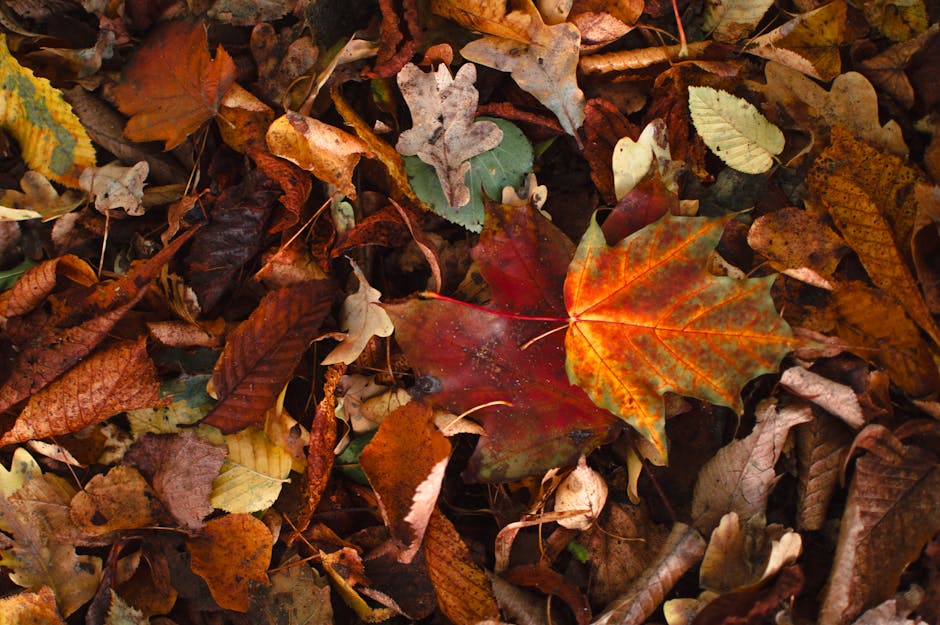
Tucked in the Texas Hill Country, Lost Maples State Natural Area gives you a rare chance to see true autumn colors in the South. The park mixes rugged limestone canyons, the Sabinal River, and stands of bigtooth maples that light up the landscape in late October and November.
Fiery Maple Groves and Diverse Foliage
You’ll find the park’s star attraction in its groves of Uvalde bigtooth maples. These trees turn brilliant shades of red, orange, and yellow each fall, creating a display that feels unusual for Texas.
Alongside the maples, you’ll also notice sycamores, oaks, and Texas madrones. Their golden and deep green tones add variety to the scenery. This mix gives the canyon walls a layered look, especially when sunlight filters through the leaves.
Unlike many parks where fall color is brief, the season here can stretch for several weeks. The timing depends on rainfall and temperature, so each year feels a little different. If you want the brightest colors, mid-November usually offers the most consistent show.
Top Hiking Trails for Peak Colors
Lost Maples has over 10 miles of hiking trails, and each one gives you a different view of the fall season. The East Trail takes you through dense maple groves and along the Sabinal River, making it one of the best routes for color.
The West Trail is longer and more rugged, climbing to a 2,200-foot cliff with wide canyon views. From the top, you’ll see entire valleys painted in autumn shades. It’s a tougher hike, but the reward is worth the effort.
If you prefer something shorter, the Maples Trail offers a quick walk right into the heart of the foliage. This trail is less than a mile, so you can enjoy the colors without committing to a long trek.
Quiet Retreats Away from Crowds
Even during peak fall weekends, you can find quiet corners in Lost Maples. Primitive campsites tucked deeper into the backcountry give you space to enjoy the scenery without much company.
Fishing along the Sabinal River or Can Creek is another way to escape the busy trails. You don’t need a license to fish from shore, and the calm water reflects the surrounding trees.
Birdwatching also offers peaceful moments. The park is home to species like the golden-cheeked warbler, and spotting wildlife often takes you to less-traveled areas. If you want a slower pace, bring binoculars and settle into a clearing surrounded by maples.

